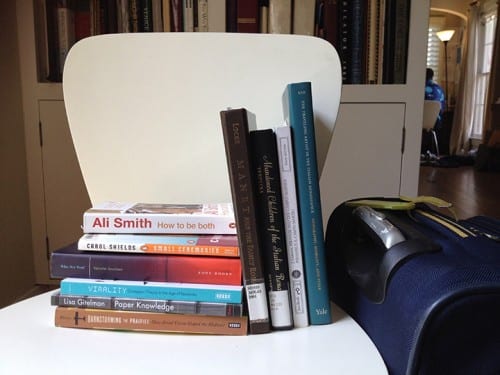
I am packing my books—yes, I am. They have come off various shelves, and unlike the dwelling of books Walter Benjamin built, or the volumes already chosen and boxed for sabbatical recently featured here, this bookshelf is indeed still “open.” The books are not yet in the box, as I ponder what I most would like to read —and to carry!—during the travels that began with the summer. Some candidates (the bottom four horizontal ones) come from the just-concluded inaugural “RASC/a Double” graduate seminar I co-taught—and all are ones I’d like to continue to peruse. There are a couple of novels on top, to celebrate the end of semester. And upright at the right are some books to feed my current writing projects that, like the others, explore issues of visibility, identity, and mobility.
Ali Smith, How to be Both (New York: Pantheon Books, 2014)
Carol Shields, Small Ceremonies (New York: Penguin, 1976)
Valentin Groebner, Who Are You?: Identification, Deception, and Surveillance in Early Modern Europe (Brooklyn, NY: Zone, 2007)
Tony Sampson, Virality: Contagion Theory in the Age of Networks (Minneapolis: University of Minnesota Press, 2012)
Lisa Gitelman, Paper Knowledge: Toward a Media History of Documents (Durham, NC: Duke University Press, 2014)
Jason Weems, Barnstorming the Prairies: How Aerial Vision Shaped the Midwest (Minneapolis: University of Minnesota Press, 2015)
Nancy Locke, Manet and the Family Romance (Princeton, NJ: Princeton University Press, 2001)
Nicholas Terpstra, Abandoned Children of the Italian Renaissance: Orphan Care in Florence and Bologna (Baltimore, MD: Johns Hopkins University Press, 2005)
Joseph Connors, Piranesi and the Campus Martius: The Missing Corso: Topography and Archaeology in Eighteenth-Century Rome (Milan: Jaca Book, 2011)
David Young Kim, The Traveling Artist in the Italian Renaissance; Geography, Mobility, and Style (New Haven: Yale University Press, 2014)
Lisa Pon, a specialist in early-sixteenth-century Italian art, architecture, and material culture, is currently professor of art history at Southern Methodist University (SMU). Her research and teaching focus on the mobilities of art and its viewers, the authority of the artist, and the work of art as religious image. She is the author of Raphael, Dürer, and Marcantonio Raimondi: Copying and the Italian Renaissance Print (New Haven: Yale, 2004) and Printed Icon: Forlì’s Madonna of the Fire (New York: Cambridge, 2015), and co-edited, with Craig Kallendorf, The Books of Venice/Il Libro Veneziano (Venice, Italy: Talìa Editrice, 2008). Her articles have appeared in journals including The Art Bulletin, Art History, Medical Humanities, Word & Image, and Acta Acustica. She is working on two book projects, one on collaboration in the Renaissance and the other on contagion in early modern Venice. In spring 2016, Pon co-taught the seminar “Print, Identity, and the Im/Material Image” with her colleague at SMU, Beatriz Balanta. This innovative class explored issues raised by their department’s curricular initiative, Rhetorics of Art, Space, and Culture (RASC/a). RASC/a challenges us to consider how visual images, material objects, and the spaces around them can be studied from new perspectives within and beyond categories often first defined by geography and chronology.

